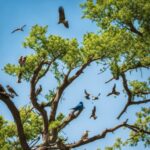If you are looking for a new hobby that gets you outside and in touch with nature, bird watching is what you need. Birding is the observation and study of birds in their natural habitat. It is a popular hobby for people of all ages and skill levels and can be enjoyed almost anywhere.
Understanding Bird Watching
Whether you are a beginner or an experienced birder, there are a few basics you should know to get started, and there is always something new to learn and discover in the world of birds.
Be respectful of the birds and their habitats, avoid disturbing nesting birds, and be mindful of your environmental impact. The American Birding Association has a code of ethics for birders that outlines best practices for responsible bird watching.
Bird Watching Basics – Essential Equipment
To begin bird watching, you need binoculars, a field guide, and a willingness to be patient and observant. With these tools, you can start identifying different species of birds and learning about their habits and behaviours. To get started with bird watching, you will need some essential equipment.
Binoculars are the most crucial piece of equipment for bird watching. They allow you to see birds up close without disturbing them. When choosing binoculars, look for ones with a magnification of at least 7 – 8x and an objective lens diameter of at least 32mm, as this will give you a clear and bright image of the birds. Our buyers’ guide …
A camera is optional but can help take photos of the birds you see. A point-and-shoot camera or a smartphone with a good camera will suffice. However, if you are serious about bird photography, you should invest in a DSLR camera with a telephoto lens. A strap for your binoculars or camera can be helpful to keep them secure around your neck or on your chest. This way, you can easily access them when you need them without fumbling around.
Bird watching can involve long hours of standing or sitting in one place, which can be uncomfortable, so you need the right gear. Consider wearing comfortable shoes, layer your clothing to add to or remove to keep your body temperature correct and bring a chair or stool to sit on.
Wear comfortable, lightweight clothing that allows you to move freely. Opt for neutral colours such as khaki, brown, or green, which will help you blend in with your surroundings and avoid scaring birds away.
As for footwear, choose a pair of comfortable shoes or boots that provide good support and grip. You may be walking on uneven terrain, so ensure your shoes are sturdy and have a good tread. A hat and sunscreen are also helpful to your comfort, even on cloudy days.
Bird Watching Basics -Identifying Birds
Identifying birds can be challenging for beginners, but it can become a rewarding experience with practice and patience. Keep going even if you cannot locate or identify a bird immediately. Observing and learning will make you more confident and knowledgeable about bird identification. Here are a few tips to help you get started:
Size and Sight – When you are out birding, be patient and observant. Birds can be difficult to spot, especially when they hide in trees or bushes. The size and shape of a bird provide essential clues for identification. Look closely at the bird to see its overall size, shape, and proportions, as well as the size and shape of its beak, tail, and wings. Also, observe the bird’s coloration, markings, and patterns, as well as its behaviour and habitat.
Behaviour and Food – Birds have different behaviours and feeding habits, which can help with identification. Some birds are ground feeders, while others feed on insects, fruits, or seeds. Observe how the bird moves, flies and interacts with other birds.
Songs and Calls – For individuals who enjoy observing birds, developing the ability to recognize the unique songs and calls of various bird species is an essential skill. This expertise allows bird watchers to better identify and appreciate the diverse range of natural birds by their distinct vocalizations identification when birds are not visible. Learn to recognize the sounds of common birds in your area, and use a birding app or field guide to help you identify unfamiliar ones. The website All About Birds is an excellent resource for learning bird songs and calls.
Bird Watching Field Guides, Range Maps, Websites, Apps And Books
When it comes to bird watching, having access to reliable guides and websites can be incredibly helpful. Here are some resources you can use to enhance your bird watching experience:
Bird Watching Websites
Several websites provide information on bird identification, behaviour, and distribution. Some of the most popular ones include:
- eBird: This website lets you track bird sightings, explore birding hotspots, and view species distribution maps.
- All About Birds: This website is run by the Cornell Lab of Ornithology and provides detailed information on bird identification, behaviour, and conservation.
- BirdWatchingDaily: This website includes news, articles, bird watching and conservation tips.
Bird Watching Books
There are many bird identification guides available, but the most popular ones include:
- The Sibley Guide to Birds: This guide by David Allen Sibley is known for its detailed illustrations and comprehensive information on North American birds.
- National Geographic Field Guide to the Birds of North America includes detailed information on over 1,000 North American bird species, range maps and illustrations.
Bird Watching Mobile Apps
Several mobile apps can be helpful for bird watching, including:
- Merlin Bird ID: This app, developed by the Cornell Lab of Ornithology, allows you to identify birds by answering simple questions or uploading a photo.
- eBird Mobile: This app will enable you to enter and track your bird sightings on the go, even when you don’t have an internet connection.
Rare Bird Watching Alerts
If you’re interested in finding rare or unusual birds, there are several resources you can use to stay up-to-date on sightings in your area. Some of these include:
- ABA Rare Bird Alert: This service provides email notifications of rare bird sightings across North America.
- eBird Alerts: This feature allows you to set up alerts for specific bird species or locations so you will be notified when a rare bird is reported.
Bird Watching Life List
A life list is a record of all the bird species you have seen in your lifetime. Keeping a life list can be a fun way to track your bird watching progress and set goals for future sightings. Many bird watching apps and websites allow you to keep a digital life list, but you can also save a physical inventory in a notebook or journal.
Best Locations for Bird Watching
The location you choose to go to bird watch can make all the difference concerning your success. Here are some of the best spots for bird watching:
Parks and Habitats – Parks and habitats are often excellent spots for bird watching, as they offer various species and habitats. Many parks have designated bird watching areas, so check with the park’s staff or website to find out where these areas are located. Some popular parks for bird watching include Central Park in New York City, the Great Smoky Mountains National Park in Tennessee, and the Everglades National Park in Florida.
Local Parks and Gardens – If you do not have the time or resources to travel to a national park, a cost effective way is to bird watch at your local parks and gardens, as they can provide excellent bird watching opportunities. Look for parks and gardens with various trees, shrubs, and flowers, which can attract diverse bird species, or you could set up a bird feeder in your backyard to attract birds.
Migration Routes – During migration season, birds travel long distances to reach their breeding or wintering grounds. These migration routes can be great bird watching spots, as you can see various species in one location. Some popular migration routes in the United States include the Gulf Coast of Texas, the Great Lakes region, and the Pacific Coast.
Audubon Centers and Sanctuaries – The Audubon Society is a nonprofit organization that conserves birds and their habitats. They have centers and sanctuaries throughout the United States, offering incredible bird watching opportunities. These centers often have knowledgeable staff and volunteers who can help you identify different bird species and provide information about their habitats and behaviours.
Travel Destinations – If you want to combine your love of bird watching with travel, many destinations worldwide offer bird watching opportunities. Some famous international bird watching destinations include Costa Rica, the Galapagos Islands, and South Africa.
Timing for Bird Watching
Knowing the activity patterns of different birds is crucial for bird watching. Understanding when they are most active can significantly increase your chances of spotting them. Here are some things to keep in mind when it comes to timing for bird watching:
Birds are most active in the early morning and late afternoon due to cooler temperatures and less resource competition. If you are a morning person, you are in luck when it comes to bird watching. The early morning hours are some of the best times to spot birds. As the sun rises, many bird species become more active, making it the perfect time to head out and start your bird watching adventure. During these times, birds are likelier to engage in behaviours such as feeding, singing, and socializing.
Every year, North America hosts an event called the Christmas Bird Count. Bird enthusiasts participate by observing and counting numerous bird species within 24 hours. This event happens in mid-December, providing a great chance to witness various bird species.
When it comes to bird watching, timing is everything. Understanding when different bird species are most active can increase your chances of spotting them. Whether you are an early bird or prefer to watch in the late afternoon, there is always something to see when bird watching.
Bird Watching As A Sustainable Practice
Bird watching is an enjoyable and fulfilling leisure pursuit promoting sustainable habits. By using binoculars instead of approaching too closely, you can observe the birds without causing them any harm. This sustainable practice raises awareness of the need to protect natural habitats and preserve native bird species.
A great way to support sustainability while bird watching is to plant native plants in your yard. These plants offer a source of food and shelter for birds, promoting a healthy ecosystem and potentially increasing the bird population. With a bird-friendly environment, you can attract more birds to your area and observe them in their natural habitat.
It’s also important to be aware of the impact of human activities on bird habitats. Avoid disturbing nesting sites or feeding birds human food, as this can disrupt their natural behaviour and harm their health. Instead, observe birds from a distance and let them live naturally.
Feeding Birds
If you want to attract different types of birds to your yard, you can do so by offering them food. Various bird feeders are available in different shapes and sizes, including tubes, hoppers, platforms, and suet feeders. Tube feeders work well for small birds like finches, while platform feeders are more suitable for larger birds such as jays and doves. To attract the birds you want, it’s important to choose a feeder that’s appropriate for them.
Different birds have different food preferences. Finches are fond of nyjer seeds, while cardinals prefer sunflower seeds. Black oil sunflower seeds and nuts such as peanuts and almonds are popular with some birds.
If you want to attract hummingbirds, you will need a unique feeder that dispenses nectar. You can make your own nectar by mixing one part sugar with four parts water, and boiling the mixture for a few minutes until the sugar dissolves. Let the nectar cool before filling the feeder.
Here are some additional tips to keep in mind when feeding birds:
- Keep your feeder clean and dry to prevent mold and bacteria growth.
- Place your feeder safely away from predators like cats and squirrels.
- Fill your feeder with various foods to attract a broader range of birds.
- Avoid pesticides and herbicides in your yard, as they can harm birds and their food sources.
Budgeting for Bird Watching
Bird watching as a hobby can be enjoyed by anyone, regardless of their budget. You do not need to spend a lot of money to get started.
Before you start bird watching as a hobby, set a budget. Decide how much money you will spend on equipment, travel, and other expenses, as this will help you avoid overspending and keep your hobby affordable.
Having a good pair of binoculars is crucial for bird watching. You don’t have to break the bank, but investing in a durable, high-quality pair is important. When selecting binoculars, a magnification of at least 7-8x and a lens diameter of at least 32mm will work.
Joining a bird watching club is a great way to save money. Many clubs offer free or low cost bird watching tours and events. You will also be able to learn from experienced bird watchers and get advice on equipment and travel.
If planning a bird watching trip, consider budget friendly travel options. Camping instead of staying in a hotel or searching for flight and rental car deals can help you save money. You can also book your trip in advance or during the off season to cut costs. Africa is an excellent bird watching destination that may be more affordable than you think. Many African countries offer budget friendly tours and accommodations, and you’ll have the chance to see a variety of bird species. Do your research and book your trip with a reputable tour operator.
Final Thoughts
Bird watching can be done in your backyard, at a local park, or on a nature trail, making it a versatile and accessible hobby for those interested in exploring the natural world. Whether you are interested in the science of ornithology or enjoy the beauty of birds, bird watching is a hobby anyone can enjoy. With some knowledge and practice, you can become a skilled bird watcher and gain a deeper appreciation for the natural world around you.
Frequently Asked Questions
What is the difference between birding and bird watching?
Birding and bird watching are often used interchangeably, but there is a subtle difference between the two. Birding tends to be a more serious pursuit, with birders often travelling long distances to see rare or exotic species. On the other hand, bird watching is often a more casual hobby, with birders observing birds in their local area.
How can I find good bird watching spots near me?
There are several ways to find good bird watching spots near you. One option is to check with local birding groups or Audubon societies. These organizations often have information on local birding hotspots. You can also check with your local parks and wildlife management areas. Finally, online resources such as eBird can provide information on recent bird sightings in your area.
What are some benefits of bird watching?
Bird watching can provide several benefits, both physical and mental. Spending leisure time outdoors can help reduce stress and improve mood. Bird watching can also be a great form of exercise, particularly if you’re hiking or walking to find birds. Finally, bird watching can be a great way to connect with nature and learn more about the world around you.






